ECO mode PORSCHE 911 TURBO 2004 4.G Information Manual
[x] Cancel search | Manufacturer: PORSCHE, Model Year: 2004, Model line: 911 TURBO, Model: PORSCHE 911 TURBO 2004 4.GPages: 61, PDF Size: 2.14 MB
Page 5 of 61
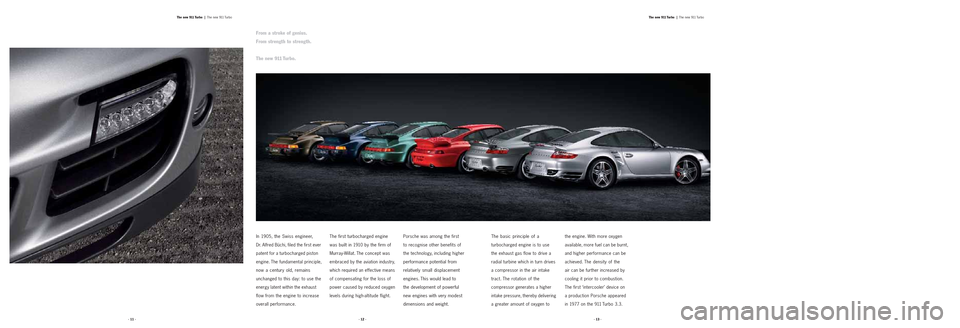
· 13 ·The new 911 Turbo |
The new 911 TurboThe new 911 Turbo |The new 911 Turbo
In 1905, the Swiss engineer,
Dr. Alfred Büchi, filed the first ever
patent for a turbocharged piston
engine. The fundamental principle,
now a century old, remains
unchanged to this day: to use the
energy latent within the exhaust
flow from the engine to increase
overall performance.
The first turbocharged engine
was built in 1910 by the firm of
Murray-Willat. The concept was
embraced by the aviation industry,
which required an effective means
of compensating for the loss of
power caused by reduced oxygen
levels during high-altitude flight.Porsche was among the first
to recognise other benefits of
the technology, including higher
performance potential from
relatively small displacement
engines. This would lead to
the development of powerful
new engines with very modest
dimensions and weight.
The basic principle of a
turbocharged engine is to use
the exhaust gas flow to drive a
radial turbine which in turn drives
a compressor in the air intake
tract. The rotation of the
compressor generates a higher
intake pressure, thereby delivering
a greater amount of oxygen to
the engine. With more oxygen
available, more fuel can be burnt,
and higher performance can be
achieved. The density of the
air can be further increased by
cooling it prior to combustion.
The first ‘intercooler’ device on
a production Porsche appeared
in 1977 on the 911 Turbo 3.3.
· 12 · · 11 ·
From a stroke of genius.
From strength to strength.
The new 911 Turbo.
Page 6 of 61
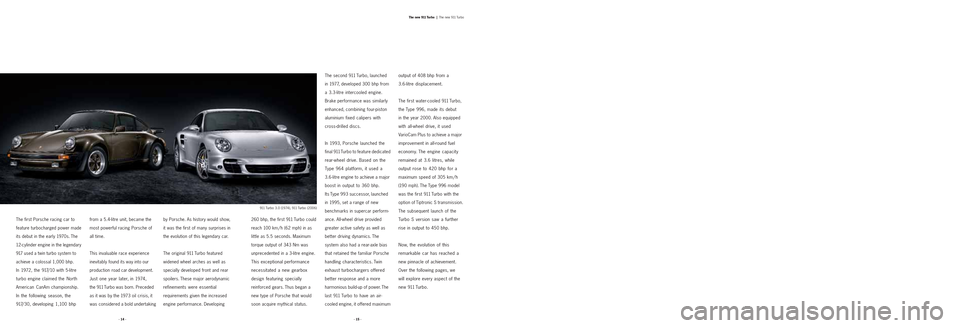
· 14 ·· 15 ·The new 911 Turbo |
The new 911 Turbo
The second 911 Turbo, launched
in 1977, developed 300 bhp from
a 3.3-litre intercooled engine.
Brake performance was similarly
enhanced, combining four-piston
aluminium fixed calipers with
cross-drilled discs.
In 1993, Porsche launched the
final 911Turbo to feature dedicated
rear-wheel drive. Based on the
Type 964 platform, it used a
3.6-litre engine to achieve a major
boost in output to 360 bhp.
Its Type 993 successor, launched
in 1995, set a range of new
benchmarks in supercar perform-
ance. All-wheel drive provided
greater active safety as well as
better driving dynamics. The
system also had a rear-axle bias
that retained the familiar Porsche
handling characteristics. Twin
exhaust turbochargers offered
better response and a more
harmonious build-up of power. The
last 911 Turbo to have an air-
cooled engine, it offered maximum
output of 408 bhp from a
3.6-litre displacement.
The first water-cooled 911 Turbo,
the Type 996, made its debut
in the year 2000. Also equipped
with all-wheel drive, it used
VarioCam Plus to achieve a major
improvement in all-round fuel
economy. The engine capacity
remained at 3.6 litres, while
output rose to 420 bhp fo r a
maximum speed of 305 km / h
(190 mph). The Type 996 model
was the first 911 Turbo with the
option of Tiptronic S transmission.
The subsequent launch of the
Turbo S version saw a further
rise in output to 450 bhp.
Now, the evolution of this
remarkable car has reached a
new pinnacle of achievement.
Over the following pages, we
will explore every aspect of the
new 911 Turbo.The first Porsche racing car to
feature turbocharged power made
its debut in the early 1970s. The
12-cylinder engine in the legendary
917 used a twin turbo system to
achieve a colossal 1,000 bhp
.
In 1972, the 917/10 with 5-litre
turbo engine claimed the North
American CanAm
championship.
In the following season, the
917/30, developing 1,100 bhp
from a 5.4-litre unit, became the
most powerful racing Porsche of
all time.
This invaluable race experience
inevitably found its way into our
production
road car development.
Just one year later, in 1974,
the 911 Turbo was born. Preceded
as it was by the 1973 oil crisis, it
was considered a
bold undertakingby Porsche. As history would show,
it was the first of many surprises in
the evolution of this legendary car.
The original 911 Turbo featured
widened wheel arches as well as
specially developed front and rear
spoilers. These major aerodynamic
refinements were essential
requirements given the increased
engine performance. Developing260 bhp, the first 911 Turbo could
reach 100 km / h (62 mph) in as
little as 5.5 seconds. Maximum
torque output of 343 Nm was
unprecedented in a 3-litre engine.
This exceptional performance
necessitated a new gearbox
design featuring specially
reinforced gears. Thus began a
new type of Porsche that would
soon acquire mythical status.
911 Turbo 3.0 (1974), 911 Turbo (2006)
Page 8 of 61
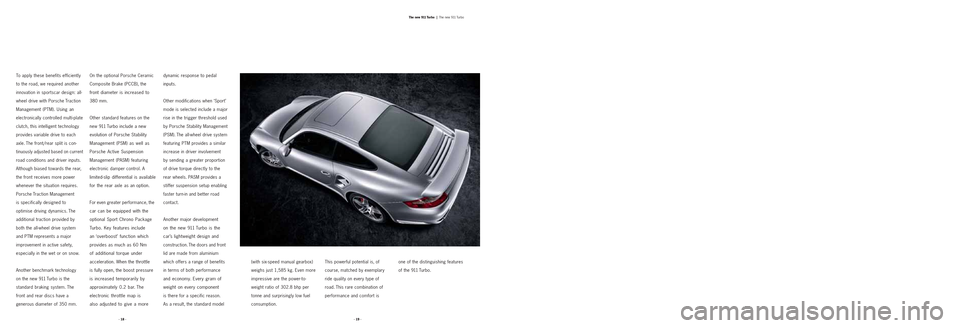
To apply these benefits efficiently
to the road, we required another
innovation in sportscar design: all-
wheel drive with Porsche Traction
Management (PTM). Using an
electronically controlled multi-plate
clutch, this intelligent technology
provides variable drive to each
axle. The front/rear split is con-
tin
uously adjusted based on current
road conditions and driver inputs.
Although biased towards the rear,
the front receives more power
whenever the situation requires.
Porsche Traction Management
is specifically designed to
optimise driving dynamics. The
additional traction provided by
both the all-wheel drive system
and PTM represents a major
improvement in active safety,
especially in the wet or on snow.
Another benchmark technology
on the new 911 Turbo is the
standard braking system. The
front and rear discs have a
generous diameter of 350 mm.On the optional Porsche Ceramic
Composite Brake (PCCB), the
front diameter is increased to
380 mm.
Other standard features on the
new 911 Turbo include a new
evolution of Porsche Stability
Management (PSM) as well as
Porsche Active Suspension
Management (PASM) featuring
electronic damper control.
A
limited-slip differential is available
for the rear axle as an option.
For even greater performance, the
car can be equipped with the
optional Sport Chrono Package
Turbo. Key features include
an ‘overboost’ function which
provides as much as 60 Nm
of additional torque under
acceleration. When the throttle
is fully open, the boost pressure
is increased temporarily by
approximately 0.2 bar. The
electronic throttle map is
also adjusted to give a more
dynamic response to pedal
inputs.
Other modifications when ‘Sport’
mode is selected include a major
rise in the trigger threshold used
by Porsche Stability Management
(PSM). The all-wheel drive system
featuring PTM provides a similar
increase in driver involvement
by sending a greater proportion
of drive torque directly to the
rear wheels. PASM provides a
stiffer suspension setup enabling
faster turn-in and better road
contact.
Another major development
on the new 911 Turbo is the
car’s lightweight design and
construction. The doors and front
lid are made from aluminium
which offers a range of benefits
in terms of both performance
and economy. Every gram of
weight on every component
is there for a specific reason.
As a result, the standard model (with six-speed manual gearbox)
weighs just 1,585 kg. Even more
impressive are the power-to-
weight ratio of 302.8 bhp per
tonne and surprisingly low fuel
consumption.This powerful potential is, of
course, matched by exemplary
ride quality on every type of
road. This rare combination of
performance and comfort is one of the distinguishing features
of the 911 Turbo.
· 18 ·· 19 ·The new 911 Turbo |
The new 911 Turbo
Page 19 of 61
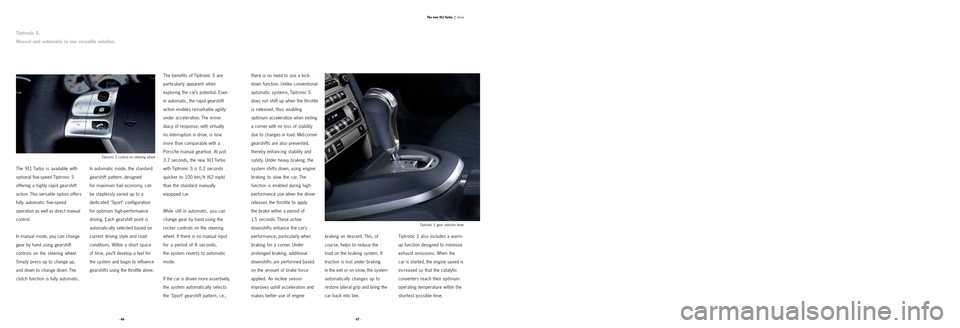
Tiptronic S also includes a warm-
up function designed to minimise
exhaust emissions. When the
car is started, the engine speed is
increased so that the catalytic
converters reach their optimum
operating temperature within the
shortest possible time. braking on descent. This, of
course, helps to reduce the
load on the braking system. If
traction is lost under braking
in the wet or on snow, the system
automatically changes up to
restore lateral grip and bring the
car back into line. there is no need to use a kick-
down function. Unlike conventional
automatic systems, Tiptronic S
does not shift up when the throttle
is released, thus enabling
optimum acceleration when exiting
a corner with no loss of stability
due to changes in load. Mid-corner
gearshifts are also prevented,
thereby enhancing stability and
safety. Under heavy braking, the
system shifts down, using engine
braking to slow the car. The
function is enabled during high-
performance use when the driver
releases the throttle to apply
the brake within a period of
1.5 seconds. These active
downshifts enhance the car’s
performance, particularly when
braking for a corner. Under
prolonged braking, additional
downshifts are performed based
on the amount of brake force
applied. An incline sensor
improves uphill acceleration and
makes better use of engine
The 911 Turbo is available with
optional five-speed Tiptronic S
offering a highly rapid gearshift
action. This versatile option offers
fully automatic five-speed
operation as well as direct manual
control.
In manual mode, you can change
gear by hand using gearshift
controls on the steering wheel.
Simply press up to change up,
and down to change down. The
clutch function is fully automatic.In automatic mode, the standard
gearshift pattern, designed
for maximum fuel economy, can
be steplessly varied up to a
dedicated ‘Sport’ configuration
for optimum high-performance
driving. Each gearshift point is
automatically selected based on
current driving style and road
conditions. Within a short space
of time, you’ll develop a feel for
the system and begin to influence
gearshifts using the throttle alone.
The benefits of Tiptronic S are
particularly apparent when
exploring the car’s potential. Even
in automatic, the rapid gearshift
action enables remarkable agility
under acceleration. The imme-
diacy of response, with virtually
no interruption in drive, is now
more than comparable with a
Porsche manual gearbox. At just
3.7 seconds, the new 911 Turbo
with Tiptronic S is 0.2 seconds
quicker to 100 km / h (62 mph)
than the standard manually
equipped car.
While still in automatic, you can
change gear by hand using the
rocker controls on the steering
wheel. If there is no manual input
for a period of 8 seconds,
the system reverts to automatic
mode.
If the car is driven more assertively,
the system automatically selects
the ‘Sport’ gearshift pattern, i.e.,
· 46 ·· 47 ·The new 911 Turbo |
Drive
Tiptronic S gear selector lever Tiptronic S control on steering wheel
Tiptronic S.
Manual and automatic in one versatile solution.
Page 24 of 61
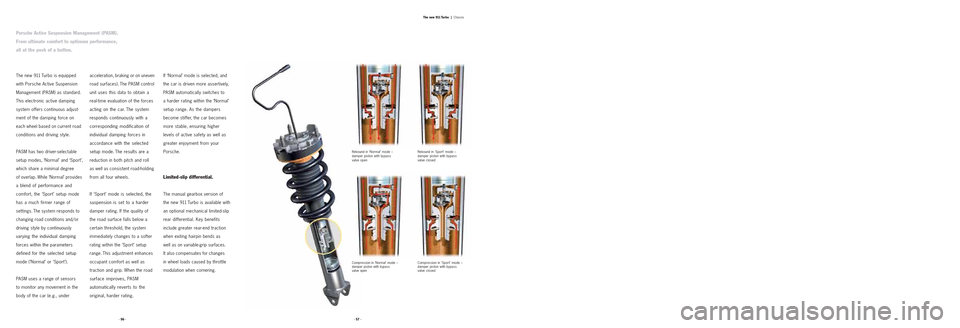
The new 911 Turbo is equipped
with Porsche Active Suspension
Management (PASM) as standard.
This electronic active damping
system offers continuous adjust-
ment of the damping force on
each wheel based on current road
conditions and driving style.
PASM has two driver-selectable
setup modes, ‘Normal’ and ‘Sport’,
which share a minimal degree
of overlap. While ‘Normal’ provides
a blend of performance and
comfort, the ‘Sport’ setup mode
has a much firmer range of
settings. The system responds to
changing road conditions and/or
driving style by continuously
varying the individual damping
forces within the parameters
defined for the selected setup
mode (‘Normal’ or ‘Sport’).
PASM uses a range of sensors
to monitor any movement in the
body of the car (e.g., under
acceleration, braking or on uneven
road surfaces). The PASM control
unit uses this data to obtain a
real-time evaluation of the forces
acting on the car. The system
responds continuously with a
corresponding modification of
individual damping force s in
accordance with the selected
setup mode. The results are a
reduction in both pitch and roll
as well as consistent road-holding
from all four wheels.
If ‘Sport’ mode is selected, the
suspension is set to a harder
damper rating. If the quality of
the road surface falls below a
certain threshold, the system
immediately changes to a softer
rating within the ‘Sport’ setup
range. This adjustment enhances
occupant comfort as well as
traction and grip. When the road
surface improves, PASM
automatically reverts to the
original, harder rating.
If ‘Normal’ mode is selected, and
the car is driven more assertively,
PASM automatically switches to
a harder rating within the ‘Normal’
setup range. As the dampers
become stiffer, the car becomes
more stable, ensuring higher
levels of active safety as well as
greater enjoyment from your
Porsche.
Limited-slip differential.
The manual gearbox version of
the new 911 Turbo is available with
an optional mechanical limited-slip
rear differential. Key benefits
include greater rear-end traction
when exiting hairpin bends as
well as on variable-grip surfaces.
It also compensates for changes
in wheel loads caused by throttle
modulation when cornering.
· 56 ·· 57 ·The new 911 Turbo |
Chassis
Porsche Active Suspension Management (PASM).
From ultimate comfort to optimum performance,
all at the push of a button.
Rebound in ‘Normal’ mode –
damper piston with bypass
valve openRebound in ‘Sport’ mode –
damper piston with bypass
valve closed
Compression in ‘Sport’ mode –
damper piston with bypass
valve closedCompression in ‘Normal’ mode –
damper piston with bypass
valve open
Page 26 of 61
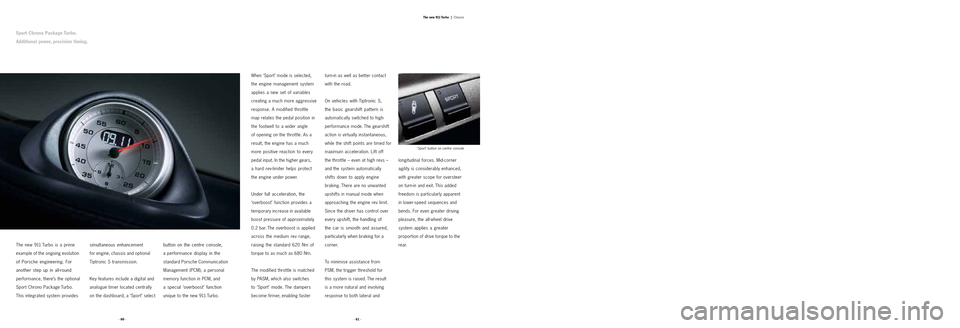
The new 911 Turbo is a prime
example of the ongoing evolution
of Porsche engineering. For
another step up in all-round
performance, there’s the optional
Sport Chrono Package Turbo.
This integrated system provides
simultaneous enhancement
for engine, chassis and optional
Tiptronic S transmission.
Key features include a digital and
analogue timer located centrally
on the dashboard, a ‘Sport’ select
button on the centre console,
a performance display in the
standard Porsche Communication
Management (PCM), a personal
memory function in PCM, and
a special ‘overboost’ function
unique to the new 911 Turbo.When ‘Sport’ mode is selected,
the engine management system
applies a new set of variables
creating a much more aggressive
response. A modified throttle
map relates the pedal position in
the footwell to a wider angle
of opening on the throttle. As a
result, the engine has a much
more positive reaction to every
pedal input. In the higher gears,
a hard rev-limiter helps protect
the engine under power.
Under full acceleration, the
‘overboost’ function provides a
temporary increase in available
boost pressure of approximately
0.2 bar. The overboost is applied
across the medium rev range,
raising the standard 620 Nm of
torque to as much as 680 Nm.
The modified throttle is matched
by PASM, which also switches
to ‘Sport’ mode. The dampers
become firmer, enabling fasterturn-in as well as better contact
with the road.
On vehicles with Tiptronic S,
the basic gearshift pattern is
automatically switched to high-
performance mode. The gearshift
action is virtually instantaneous,
while the shift points are timed for
maximum acceleration. Lift off
the throttle – even at high revs –
and the system automatically
shifts down to apply engine
braking. There are no unwanted
upshifts in manual mode when
approaching the engine rev limit.
Since the driver has control over
every upshift, the handling of
the car is smooth and assured,
particularly when braking for a
corner.
To minimise assistance from
PSM, the trigger threshold for
this system is raised. The result
is a more natural and involving
response to both lateral andlongitudinal forces. Mid-corner
agility is considerably enhanced,
with greater scope for oversteer
on turn-in and exit. This added
freedom is particularly apparent
in lower-speed sequences and
bends. For even greater driving
pleasure, the all-wheel drive
system applies a greater
proportion of drive torque to the
rear.
· 60 ·· 61 ·The new 911 Turbo |
Chassis
‘Sport’ button on centre console
Sport Chrono Package Turbo.
Additional power, precision timing.
Page 27 of 61
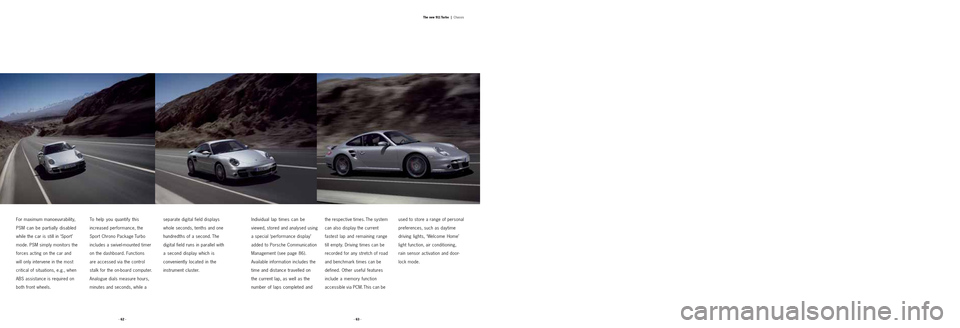
For maximum manoeuvrability,
PSM can be partially disabled
while the car is still in ‘Sport’
mode. PSM simply monitors the
forces acting on the car and
will only intervene in the most
critical of situations, e.g., when
ABS assistance is required on
both front wheels.
To help you quantify this
increased performance, the
Sport Chrono Package Turbo
includes a swivel-mounted timer
on the dashboard. Functions
are accessed via the control
stalk for the on-board computer.
Analogue dials measure hours,
minutes and seconds, while aseparate digital field displays
whole seconds, tenths and one
hundredths of a second. The
digital field runs in parallel with
a second display which is
conveniently located in the
instrument cluster.
Individual lap times can be
viewed, stored and analysed using
a special ‘performance display’
added to Porsche Communication
Management (see page 86).
Available information includes the
time and distance travelled on
the current lap, as well as the
number of laps completed and
the respective times. The system
can also display the current
fastest lap and remaining range
till empty. Driving times can be
recorded for any stretch of road
and benchmark times can be
defined. Other useful features
include a memory function
accessible via PCM. This can beused to store a range of personal
preferences, such as daytime
driving lights, ‘Welcome Home’
light function, air conditioning,
rain sensor activation and door-
lock mode.
· 62 ·· 63 ·The new 911 Turbo |
Chassis
Page 31 of 61
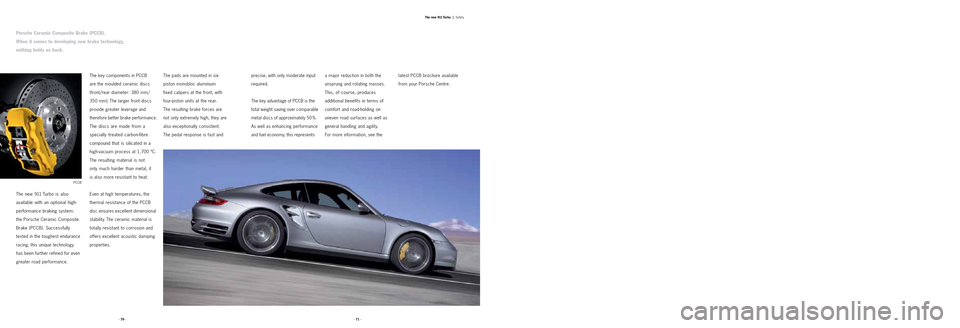
The new 911 Turbo is also
available with an optional high-
performance braking system:
the Porsche Ceramic Composite
Brake (PCCB). Successfully
tested in the toughest endurance
racing, this unique technology
has been further refined for even
greater road performance.The key components in PCCB
are the moulded ceramic discs
(front/rear diameter: 380 mm/
350 mm). The larger front discs
provide greater leverage and
therefore better brake performance.
Thediscsaremadefrom a
specially treated carbon-fibre
compound that is silicated in a
high-vacuum process at 1,700 ºC.
The resulting material is not
only much harder than metal, it
is also more resistant to heat.
Even at high temperatures, the
thermal resistance of the PCCB
disc ensures excellent dimensional
stability. The ceramic material is
totally resistant to corrosion and
offers excellent acoustic damping
properties.The pads are mounted in six-
piston monobloc aluminium
fixed calipers at the front, with
four-piston units at the rear.
The resulting brake forces are
not only extremely high, they are
also exceptionally consistent.
The pedal response is fast andprecise, with only moderate input
required.
The key advantage of PCCB is the
total weight saving over comparable
metal discs of approximately 50 %.
As well as enhancing performance
and fuel economy, this represents
a major reduction in both the
unsprung and rotating masses.
This, of course, produces
additional benefits in terms of
comfort and road-holding on
uneven road surfaces as well as
general handling and agility.
For more information, see thelatest PCCB brochure available
from your Porsche Centre.
· 70 ·· 71 ·The new 911 Turbo |
Safety
PCCB
Porsche Ceramic Composite Brake (PCCB).
When it comes to developing new brake technology,
nothing holds us back.
Page 43 of 61
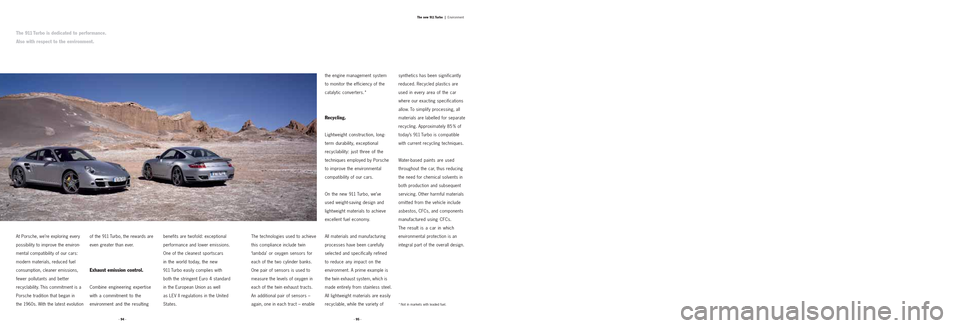
At Porsche, we’re exploring every
possibility to improve the environ-
mental compatibility of our cars:
modern materials, reduced fuel
consumption, cleaner emissions,
fewer pollutants and better
recyclability. This commitment is a
Porsche tradition that began in
the 1960s. With the latest evolutionof the 911 Turbo, the rewards are
even greater than ever.
Exhaust emission control.
Combine engineering expertise
with a commitment to the
environment and the resulting
benefits are twofold: exceptional
performance and lower emissions.
One of the cleanest sportscars
in the world today, the new
911 Turbo easily complies with
both the stringent Euro 4 standard
in the European Union as well
as LEV II regulations in the United
States.The technologies used to achieve
this compliance include twin
‘lambda’ or oxygen sensors for
each of the two cylinder banks.
One pair of sensors is used to
measure the levels of oxygen in
each of the twin exhaust tracts.
An additional pair of sensors –
again, one in each tract – enablethe engine management system
to monitor the efficiency of the
catalytic converters.*
Recycling.
Lightweight construction, long-
term durability, exceptional
recyclability: just three of the
techniques employed by Porsche
to improve the environmental
compatibility of our cars.
On the new 911 Turbo, we’ve
used weight-saving design and
lightweight materials to achieve
excellent fuel economy.
All materials and manufacturing
processes have been carefully
selected and specifically refined
to reduce any impact on the
environment. A prime example is
the twin exhaust system, which is
made entirely from stainless steel.
All lightweight materials are easily
recyclable, while the variety ofsynthetics has been significantly
reduced. Recycled plastics are
used in every area of the car
where our exacting specifications
allow. To simplify processing, all
materials are labelled for separate
recycling. Approximately 85 % of
today’s 911 Turbo is compatible
with current recycling techniques.
Water-based paints are used
throughout the car, thus reducing
the need for chemical solvents in
both production and subsequent
servicing. Other harmful materials
omitted from the vehicle include
asbestos, CFCs, and components
manufactured using CFCs.
The result is a car in which
environmental protection is an
integral part of the overall design.
· 94 ·· 95 ·The new 911 Turbo |
Environment
* Not in markets with leaded fuel.
The 911 Turbo is dedicated to performance.
Also with respect to the environment.
Page 56 of 61
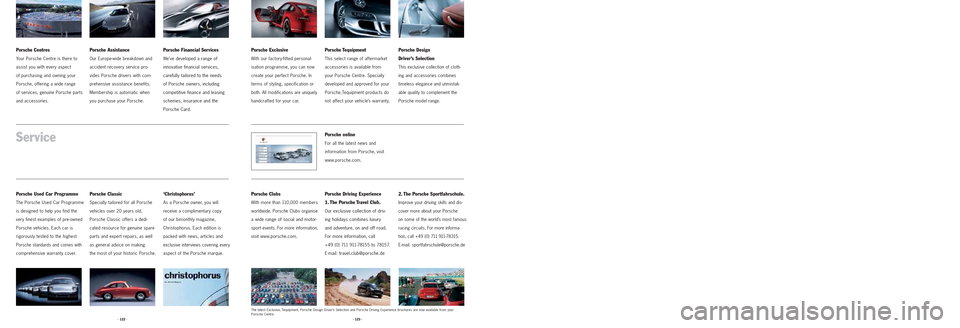
· 122 ·· 123 ·
Service
Porsche Used Car Programme
The Porsche Used Car Programme
is designed to help you find the
very finest examples of pre-owned
Porsche vehicles. Each car is
rigorously tested to the highest
Porsche standards and comes with
comprehensive warranty cover.
Porsche Financial Services
We’ve developed a range of
innovative financial services,
carefully tailored to the needs
of Porsche owners, including
competitive finance and leasing
schemes, insurance and the
Porsche Card.
Porsche Classic
Specially tailored for all Porsche
vehicles over 20 years old,
Porsche Classic offers a dedi-
cated resource for genuine spare
parts and expert repairs, as well
as general advice on making
the most of your historic Porsche.
‘Christophorus’
As a Porsche owner, you will
receive a complimentary copy
of our bimonthly magazine,
Christophorus. Each edition is
packed with news, articles and
exclusive interviews covering every
aspect of the Porsche marque.
Porsche Exclusive
With our factory-fitted personal-
isation programme, you can now
create your perfect Porsche. In
terms of styling, specification or
both. All modifications are uniquely
handcrafted for your car.
Porsche Tequipment
This select range of aftermarket
accessories is available from
your Porsche Centre. Specially
developed and approved for your
Porsche,Tequipment products do
not affect your vehicle’s warranty.
Porsche Clubs
With more than 110,000 members
worldwide, Porsche Clubs organise
a wide range of social and motor-
sport events. For more information,
visit www.porsche.com.
Porsche online
For all the latest news and
information from Porsche, visit
www.porsche.com.
Porsche Design
Driver’s Selection
This exclusive collection of cloth-
ing and accessories combines
timeless elegance and unmistak-
able quality to complement the
Porsche model range.
Porsche Driving Experience
1. The Porsche Travel Club.
Our exclusive collection of driv-
ing holidays combines luxury
and adventure, on and off road.
For more information, call
+49 (0) 711 911-78155 to 78157.
E-mail: [email protected]
Porsche Centres
Your Porsche Centre is there to
assist you with every aspect
of purchasing and owning your
Porsche, offering a wide range
of services, genuine Porsche parts
and accessories.
Porsche Assistance
Our Europe-wide breakdown and
accident recovery service pro-
vides Porsche drivers with com-
prehensive assistance benefits.
Membership is automatic when
you purchase your Porsche.
2. The Porsche Sportfahrschule.
Improve your driving skills and dis-
cover more about your Porsche
on some of the world’s most famous
racing circuits. For more informa-
tion, call +49 (0) 711 911-78315.
E-mail: [email protected]
The latest Exclusive, Tequipment, Porsche Design Driver’s Selection and Porsche Driving Experience brochures are now available from your
Porsche Centre.